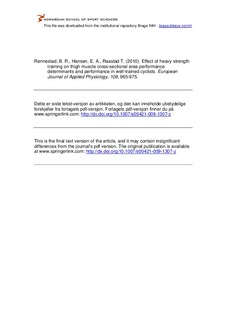| dc.contributor.author | Rønnestad, Bent R. | |
| dc.contributor.author | Hansen, Ernst Albin | |
| dc.contributor.author | Raastad, Truls | |
| dc.date.accessioned | 2011-12-07T07:48:05Z | |
| dc.date.available | 2011-12-07T07:48:05Z | |
| dc.date.issued | 2009-12 | |
| dc.identifier | Seksjon for fysisk prestasjonsevne / Department of Physical Performance | |
| dc.identifier.citation | European Journal of Applied Physiology. 2010, 108(5), 965-975 | no_NO |
| dc.identifier.issn | 1439-6327 | |
| dc.identifier.issn | 1439-6319 | |
| dc.identifier.uri | http://hdl.handle.net/11250/170863 | |
| dc.description | I Brage finner du siste tekst-versjon av artikkelen, og den kan inneholde ubetydelige forskjeller fra forlagets pdf-versjon. Forlagets pdf-versjon finner du på www.springerlink.com: http://dx.doi.org/10.1007/s00421-009-1307-z / In Brage you'll find the final text version of the article, and it may contain insignificant differences from the journal's pdf version. The original publication is available at www.springerlink.com: http://dx.doi.org/10.1007/s00421-009-1307-z | no_NO |
| dc.description.abstract | The purpose of this study was to investigate the effect of heavy strength training on thigh muscle cross-sectional area (CSA), determinants of cycling performance, and cycling performance in well-trained cyclists. Twenty well-trained cyclists were assigned to either usual endurance training combined with heavy strength training [E + S; n = 11 (♂ = 11)] or to usual endurance training only [E; n = 9 (♂ = 7, ♀ = 2)]. The strength training performed by E + S consisted of four lower body exercises [3 × 4–10 repetition maximum (RM)], which were performed twice a week for 12 weeks. Thigh muscle CSA, maximal force in isometric half squat, power output in 30 s Wingate test, maximal oxygen consumption (VO2max), power output at 2 mmol l−1 blood lactate concentration ([la−]), and performance, as mean power production, in a 40-min all-out trial were measured before and after the intervention. E + S increased thigh muscle CSA, maximal isometric force, and peak power in the Wingate test more than E. Power output at 2 mmol l−1 [la−] and mean power output in the 40-min all-out trial were improved in E + S (P < 0.05). For E, only performance in the 40-min all-out trial tended to improve (P = 0.057). The two groups showed similar increases in VO2max (P < 0.05). In conclusion, adding strength training to usual endurance training improved determinants of cycling performance as well as performance in well-trained cyclists. Of particular note is that the added strength training increased thigh muscle CSA without causing an increase in body mass. | no_NO |
| dc.language.iso | eng | no_NO |
| dc.publisher | Springer | no_NO |
| dc.subject | aerobic power output | no_NO |
| dc.subject | peak power output | no_NO |
| dc.subject | concurrent training | no_NO |
| dc.subject | weight training | no_NO |
| dc.subject | endurance performance | no_NO |
| dc.title | Effect of heavy strength training on thigh muscle cross-sectional area, performance determinants, and performance in well-trained cyclists | no_NO |
| dc.type | Journal article | no_NO |
| dc.type | Peer reviewed | no_NO |
| dc.subject.nsi | VDP::Mathematics and natural science: 400::Basic biosciences: 470 | no_NO |
| dc.source.pagenumber | 965-975 | no_NO |
| dc.source.volume | 108 | no_NO |
| dc.source.journal | European Journal of Applied Physiology | no_NO |
| dc.source.issue | 5 | no_NO |
